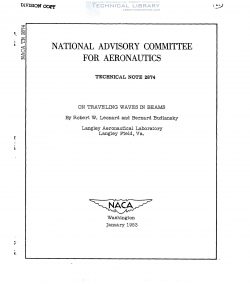naca-tn-2874
- Version
- 55 Downloads
- 1.91 MB File Size
- 1 File Count
- January 20, 2017 Create Date
- January 20, 2017 Last Updated
National Advisory Committee for Aeronautics, Technical Notes - On Traveling Waves in Beams

The basic equations of Timoshenko for the motion of vibrating non-
uniform beams, which allow for effects of transverse shear deformation
and rotary inertia, are presented in several forms, including one in
which the equations are written in the directions of the characteristics.
The propagation of discontinuities in moment and shear, as governed by
these equations, is discussed.
Numerical traveling-wave solutions are obtained for some elementary
problems of finite uniform beams for which the propagation velocities
of bending and shear discontinuities are taken to be equal. These solu—
tions are compared with modal solutions of Timoshenko' s equations and,
in some cases, with exact closed solutions.
The theoretical analysis of transient stresses in aircraft wings
and fuselages subjected to impact loadings has generally been performed
by means of a mode— —superposition method that uses the natural modes of
vibration predicted by the elementary engineering theory of beam bending.
(See, for example, refs. 1 to 3.) For very sharp impact loadings, how-
ever, this approach is known to have certain shortcomings. For sharp
impacts of short duration, many modes are often required for a satis—
factory degree of convergence (see, for example, ref. h); in addition,
the use of elementary beam theory in the calculation of the higher modes
of vibration is inaccurate because of the neglect of, among other factors,
the effects of transverse shear deformation and rotary inertia which
become increasingly important for higher and higher modes (ref. 5).
A classically recognized alternative to the modal method of calcu—
lating transient stresses.in elastic bodies is the traveling-wave approach,
which seeks to trace directly the propagation of stresses through the
body (ref. 3). Although the traveling—wave concept has been successfully
used to treat such simple problems as longitudinal and torsional impact
of rods, only recently have serious attempts been made to study the
transient bending response of beams by this approach.
| File | Action |
|---|---|
| naca-tn-2874 On Traveling Waves in Beams.pdf | Download |

Comment On This Post